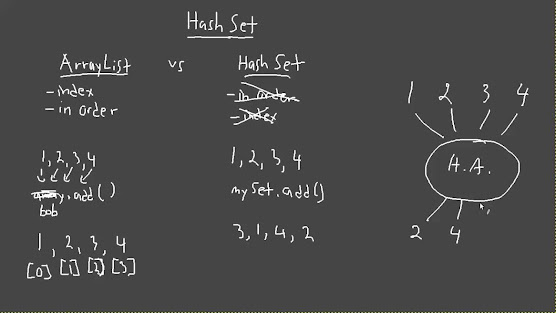ArrayList vs HashSet Java
The main difference between ArrayList and HashSet is that one is a List implementation while the other is a Set implementation. It means all the differences between a List data structure and a Set data structure also apply to this pair. For example, List implementations are ordered, it stores the element in the order they were added, while Set implementation doesn't provide such a guarantee. Similarly, since List provides Random access, you can access any element directly if you know the index, but Set doesn't provide such a facility.
You need to Iterate through the whole collection to get access to any elements. We will see a couple of more differences in this Java tutorial.
By
the way ArrayList and HashSet are the two most common Collection classes used in Java
programming language and before discussing the difference between ArrayList vs HashSet, let's see some similarities between them :
Similarities ArrayList and HashSet
Here are
couple of similarities between ArrayList
and HashSet in Java:
1) Both ArrayList and HashSet are non synchronized collection classes and not meant to be
used in multi-threading and concurrent environments. You can make ArrayList and HashSet synchronized by using Collections.synchroinzedCollection() just like we make ArrayList and HashSet read-only other days.
2) Both ArrayList and HashSet can be traversed using Iterator. This is in fact a preferred way if you want to perform operations on all elements.
3) Iterator
of ArrayList and HashSet both are fail-fast, i.e. they will throw ConcurrentModificationException if ArrayList or HashSet is modified structurally once
Iterator has been created.
Now let's
see some differences between ArrayList
and HashSet in Java
Difference between ArrayList vs HashSet in Java
Here are a couple of differences between ArrayList and HashSet in Java:
1. First and most important difference between ArrayList and HashSet is that ArrayList implements List interface while HashSet implements Set interface in Java.
2. Another difference between ArrayList and HashSet is that ArrayList allows duplicates while HashSet doesn't allow duplicates. This is
the side effect of first difference and property of implementing List and Set
interface.
3. The differences between ArrayList and HashSet is that ArrayList
is an ordered collection and maintains insertion order of elements while HashSet is an unordered collection and
doesn't maintain any order.
4. The difference between ArrayList and HashSet is that ArrayList
is backed by an Array while HashSet
is backed by a HashMap instance. See how HashSet internally works in Java for more details.
5. Fifth
difference between HashSet and ArrayList is that it's index-based you can retrieve objects by calling
get(index) or remove objects by calling remove(index) while HashSet is completely object-based. HashSet also doesn't provide the get() method.
ArrayList and HashSet Example in Java
Here's an example that demonstrates the difference between ArrayList and HashSet:
import java.util.ArrayList;
import java.util.HashSet;
import java.util.Iterator;
public class ArrayListVsHashSetExample {
public static void main(String[] args) {
// Example using ArrayList
ArrayList<String> arrayList = new ArrayList<>();
// Adding elements to ArrayList
arrayList.add("Apple");
arrayList.add("Banana");
arrayList.add("Orange");
arrayList.add("Apple"); // Duplicate element
// Displaying elements of ArrayList
System.out.println("ArrayList Elements:");
for (String fruit : arrayList) {
System.out.println(fruit);
}
// Example using HashSet
HashSet<String> hashSet = new HashSet<>();
// Adding elements to HashSet
hashSet.add("Apple");
hashSet.add("Banana");
hashSet.add("Orange");
hashSet.add("Apple"); // Duplicate element (ignored in a HashSet)
// Displaying elements of HashSet using Iterator
System.out.println("\nHashSet Elements:");
Iterator<String> iterator = hashSet.iterator();
while (iterator.hasNext()) {
System.out.println(iterator.next());
}
}
}
In the example, you can observe that the ArrayList allows the addition of duplicate elements, while the HashSet automatically ignores duplicates. The order of elements in the ArrayList is maintained, whereas the HashSet does not guarantee any specific order when iterating over elements.
Here is a nice summary of the differences between ArrayList and HashSet in Java:
That's all
on the difference between ArrayList and HashSet. these differences help you to decide where to use ArrayList and where to use HashSet in Java. in terms of performance
between ArrayList and HashSet, choose what suits best to you. the raw array has fasted among
them.
Further Learning
Difference between TreeSet and HashSet in Java
Difference between HashMap and ArrayList in Java
Further Learning
Difference between TreeSet and HashSet in Java
Difference between HashMap and ArrayList in Java

Really useful thanks
ReplyDeleteThanks
ReplyDeleteThannks... helpful :)
ReplyDeleteAnother difference is that ArrayList allows to add null value where as HashSet will throw exception if null is added.
ReplyDeleteif you add null to HashSet we will not get any Exception also you can add multiple null values only one null will be added as HashSet maintains the uniqueness
DeleteHashSet hs= new HashSet();
hs.add("Laxmi");
hs.add(null);
hs.add(null);
O/p
[null, Laxmi]
A major advantage of HashSet over ArrayList is that lookup via the contains method is O(1) vs O(n).
ReplyDeleteSo for moderate to large data a HashSet contains will vastly outperform the ArrayList contains.
If we don't have duplicate data then which one is better to use among ArrayList and HashSet? And why?
ReplyDeleteJust go with HashSet
Deletejust use HashSet if you dont wanna have any duplicated data
Delete